
Home
Services
About us
Blog
Contacts
ArduCopter Unleashed: Drone-Control Apps by A-Bots.com
ArduCopter Fundamentals & 2025 Market Snapshot
Engineering a Custom ArduCopter App: The A-Bots.com Blueprint
From Prototype to Production: ArduCopter Success Stories
ArduCopter Hub: Top Questions & Pro Tips
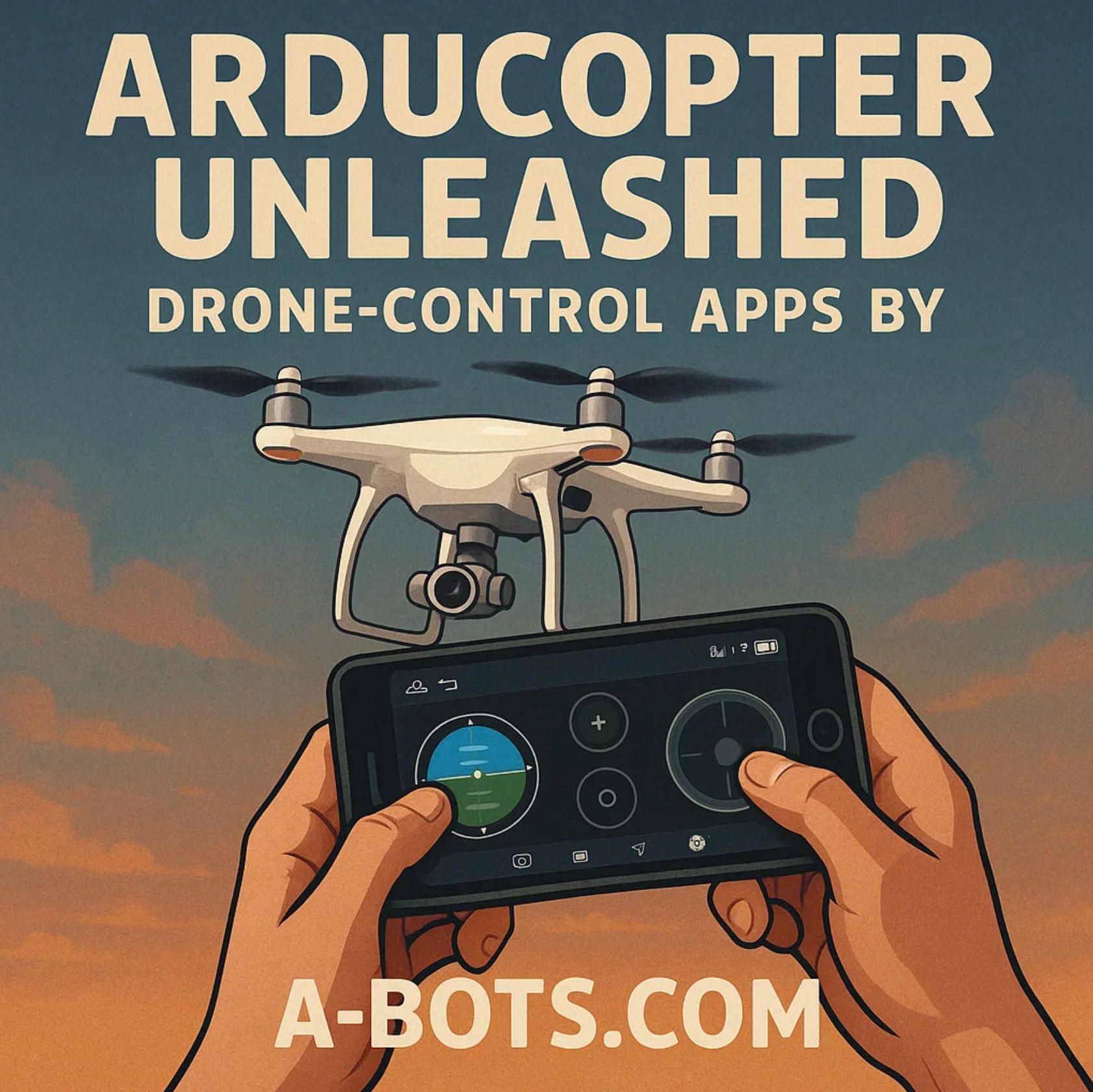
ArduCopter Fundamentals & 2025 Market Snapshot
Few open-source projects can match the pure engineering momentum behind ArduCopter—the multirotor branch of ArduPilot that now powers everything from 250 g racing quads to 40 kg ag-sprayers. As of May 2025 the core repository has logged 67 790 commits, earned more than 12 000 GitHub stars and been forked 18 600 times—hard, quantitative proof that the code base is stress-tested by a truly global talent pool (GitHub). For product teams this breadth of peer review translates into fewer edge-case failures, richer sensor drivers and a cadence of feature releases that ordinary proprietary stacks struggle to equal.
An architecture purpose-built for reliability
At the firmware layer ArduCopter follows a hardware-abstraction model that boots on 80-plus flight-controller boards—from low-cost F405 classroom boards to triple-redundant Cube Orange +. This not only frees integrators from single-vendor lock-in but lets them scale airframes or migrate to next-generation IMU/GNSS silicon without rewriting flight logic (ArduPilot Discourse).
Regulatory readiness is equally baked in. Since v4.2 the project has shipped built-in OpenDroneID Remote-ID support: just plug a Cube ID or Dronetag DRI module into a serial or DroneCAN port and the autopilot broadcasts fully compliant Bluetooth beacons—an essential checkbox as FAA Part 89 and EASA C-class rules move from guidance to enforcement (docs.cubepilot.org). Tamper-resistant firmware options prevent unauthorised downgrades, easing the certification path for commercial operators.
Developer tooling that slashes time-to-first-flight
ArduCopter’s tooling chain is equally mature. Software-in-the-Loop (SITL) lets engineers spin up native binaries on Linux, WSL 2 or macOS, run accelerated time-scales, inject GPS drop-outs, or attach Gazebo physics for wind-tunnel turbulence—all from a laptop. Mission Planner exposes identical simulation on Windows, so QA can replay bug logs while embedded teams script regression tests in Python. The net effect: parameter tuning, PID trials and swarm-logic experiments happen days—and sometimes budgets—before any carbon-fibre leaves the bench.
Governance mirrors that engineering discipline. Weekly development calls—publicly minuted on ArduPilot Discourse—triage issues, merge PRs and lock milestones, giving commercial stakeholders a transparent LTS roadmap (ArduPilot Discourse). For A-Bots.com, those predictable drops feed directly into our nightly CI pipeline, ensuring client apps track upstream security fixes without disruptive refactors.
Market signals point to accelerating demand
Open-source no longer implies “hobby.” Analysts at Global Growth Insights value the UAV-autopilot segment at USD 2.33 billion in 2025, projecting a healthy 9.3 % CAGR through 2033 as agriculture, inspection and public-safety fleets scale beyond manual control. Zooming out, Research and Markets pegs the wider universe of drone-powered business solutions at USD 17.9 billion in 2024, leaping to USD 47.5 billion by 2030 on a 17.6 % CAGR (Business Wire). Those macro-curves perfectly intersect ArduCopter’s strengths:
- Platform extensibility lets teams fold edge-AI or swarm logic into the stack without touching low-level motor code.
- Regulatory readiness via Remote-ID and ADS-B passthrough accelerates air-worthiness documentation.
- Hardware agnosticism protects cap-ex as new sensor boards hit the market.
- Community velocity turns bug fixes and feature requests into stable releases in weeks, not quarters.
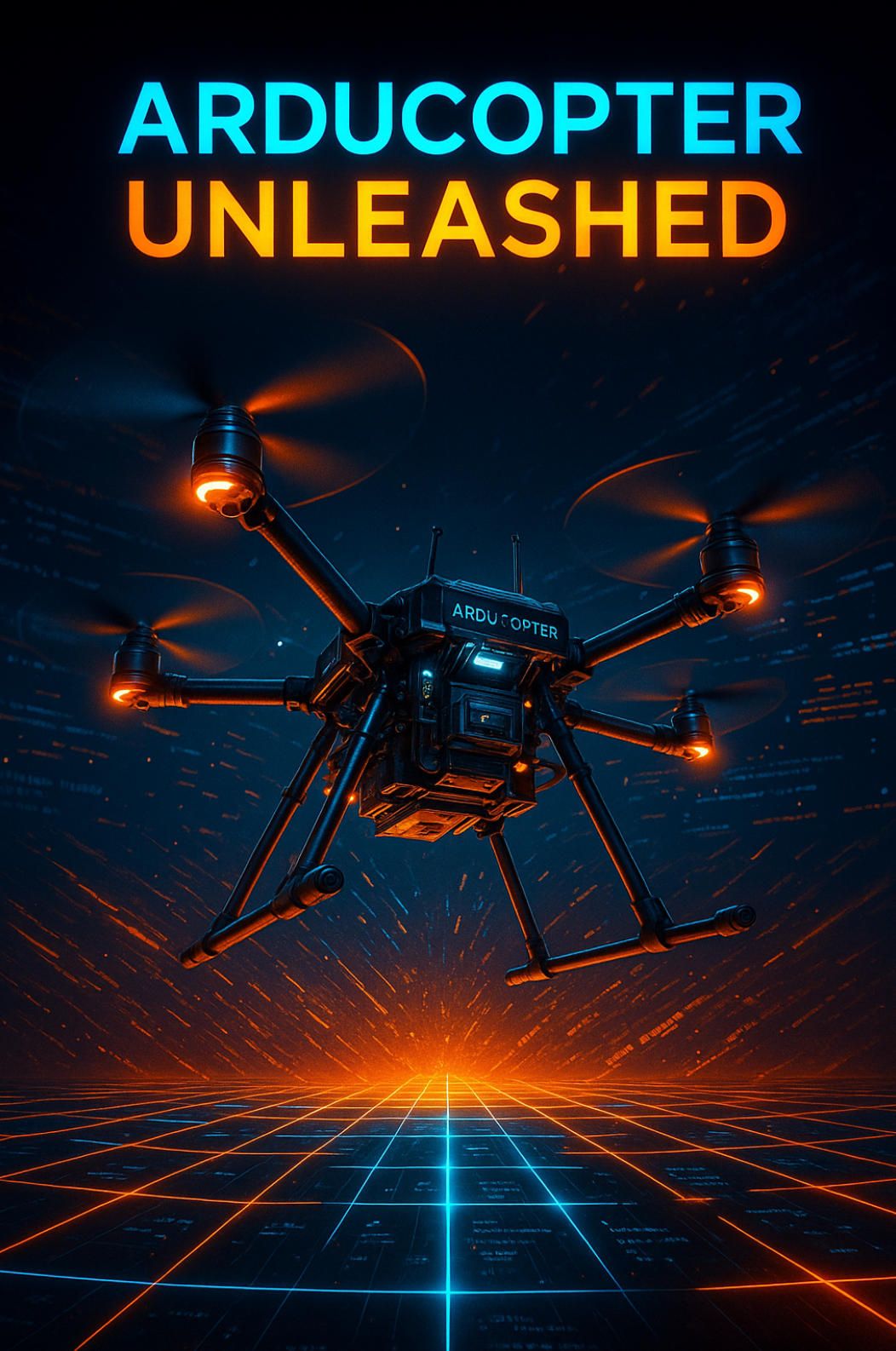
Why it matters for A-Bots.com
A-Bots.com sits squarely at this inflection point. By pairing React Native front-ends with MAVSDK-Kotlin/Swift middleware, we transform raw ArduCopter firmware capabilities into polished iOS and Android mission-control apps—complete with Remote-ID logging, BVLOS checklists and CI-verified binaries. Our “code-to-cockpit” pipeline ingests upstream changes nightly, runs them through SITL unit tests, then ships over-the-air betas—so clients inherit today’s innovations without tomorrow’s headaches.
Whether you are an energy utility automating substation inspections, a logistics start-up orchestrating last-mile deliveries, or a public-safety agency deploying rapid-response SAR drones, ArduCopter gives you the flight science while A-Bots.com delivers the user-experience layer that turns missions into revenue. The fundamentals—mature code, regulatory compliance, vast hardware choice—and the bullish market metrics together make ArduCopter not just an engineering curiosity but the logical anchor for any drone-control strategy in 2025 and beyond.
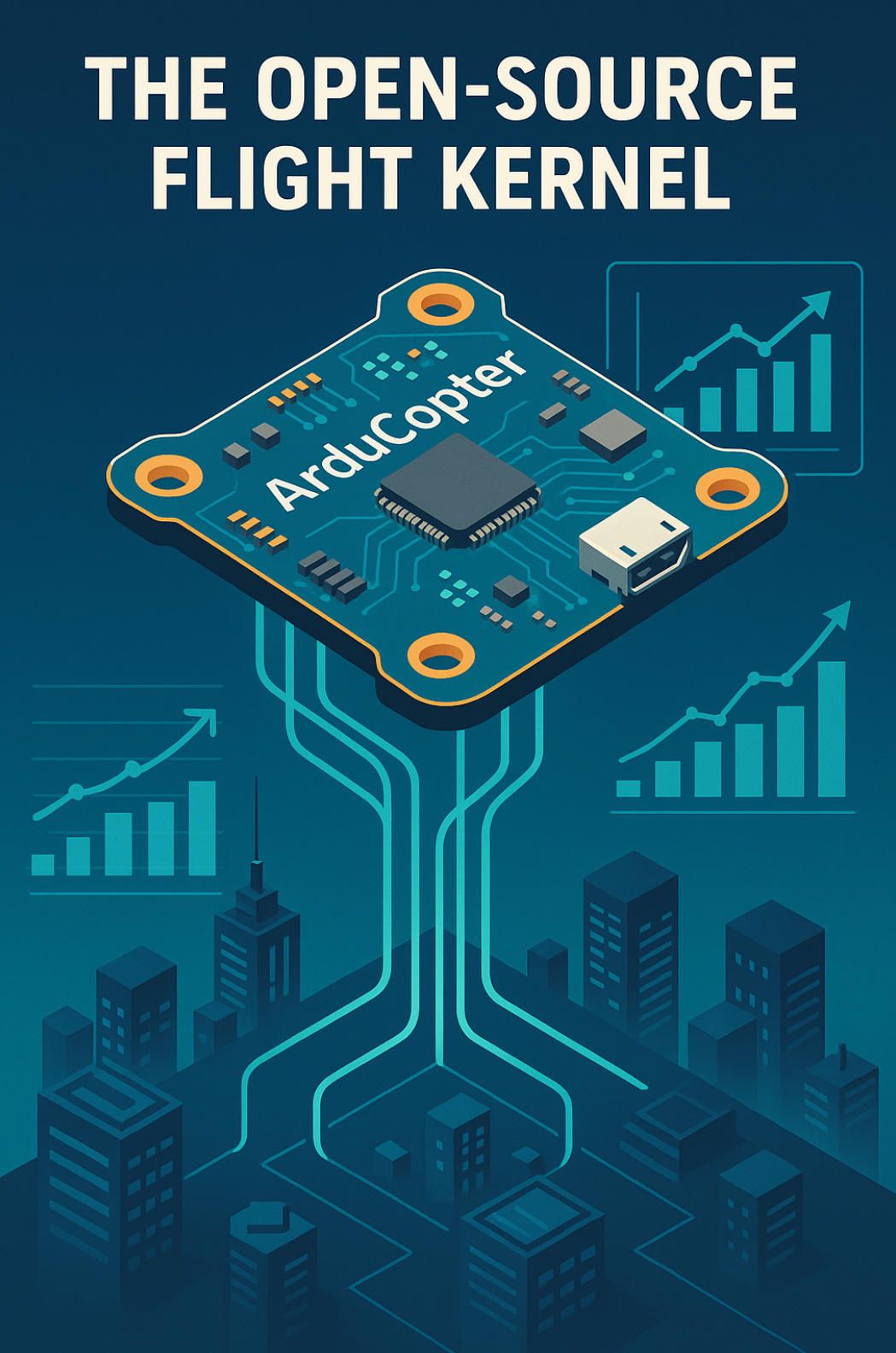
Engineering a Custom ArduCopter App: The A-Bots.com Blueprint
Building a professional drone-control application on ArduCopter starts with a simple but non-negotiable premise: every line of code must respect the flight-critical nature of the multirotor stack while adding business value the firmware alone can’t deliver. At A-Bots.com we translate that premise into a repeatable engineering blueprint that shepherds an idea from whiteboard sketch to app-store release—without ever losing upstream compatibility with the core ArduCopter firmware.
The journey begins with requirements capture that views the drone, the pilot, and the back-office as one contiguous system. Whether the mission is GNSS-denied tunnel inspection, high-volume crop spraying or long-range search-and-rescue, we interview flight crews, maintenance leads and data-analytics teams in the same workshop. That cross-functional lens surfaces edge cases the technical brief alone might miss—think battery swaps in sub-zero fields, or field-engineer hand-offs where an ArduCopter drone app must automatically load role-based geo-fences the moment a new pilot’s phone connects. Those insights feed user-flow wireframes that map every gesture, alert and checklist to a verifiable operational requirement, so the finished interface feels instantly natural to the people who trust it in the air.
Once UX is locked, our “code-to-cockpit” pipeline kicks in. The mobile front end is written in React Native, but under the hood we embed MAVSDK-Kotlin for Android and MAVSDK-Swift for iOS, guaranteeing full-fidelity MAVLink 2.0 transport with the ArduCopter flight computer. Each pull request triggers a GitHub action that spins up a containerised Software-in-the-Loop node compiled from the exact commit hash clients will flash later. In less than two minutes the CI server boots a virtual quadrotor, replays the user story—arming, take-off, mission, RTL—and asserts that telemetry frames, PID tuning endpoints and Remote-ID beacons reach the app unchanged. Failures reject the merge, so regressions never sneak into staging.
Yet desktop simulation alone is never enough. We therefore wire Hardware-in-the-Loop benches that pair a real Pixhawk 6X or Cube Orange+ running untouched ArduCopter firmware with motor-inertia emulators and load cells. This hybrid lab lets us measure latency from a thumb swipe on the phone to voltage packed into the ESC rail and then back as IMU feedback. When the spec promises sub-80 ms response for urban obstacle-slalom drones, we can prove the number with oscilloscopes rather than hopeful spreadsheets. The same bench feeds automated power-failure drills, compass-offset sweeps and fake LTE drop-outs, teaching the ground software how to degrade gracefully long before the maiden flight.
Data doesn’t vanish when the props stop. The blueprint bakes in cloud-native telemetry ingestion: each MAVLink ArduCopter packet is mirrored via MQTT to an Azure IoT Hub where stream processors classify anomalies and attach mission context—parcel ID, spray chemical, medical payload—before writing into Postgres or object storage. That real-time lake enables live dashboards for dispatchers as well as long-horizon analytics that correlate mission density with battery-cycle wear or wind-gust cancellations. For clients subject to data-residency laws we deploy the same stack on-prem via Kubernetes; a single Helm value flips the target, but the app code never changes, preserving feature parity across jurisdictions.
Security and compliance form the spine that holds the entire system upright. The mobile binaries are code-signed and notarised, while the drone-side companion computer runs WireGuard to tunnel mission traffic, shielding ArduCopter Remote-ID messages from spoofing. Each firmware build is reproducible; we store hash manifests and SBOM files so aviation auditors can trace every binary back to commit, library version and CVE status. The blueprint also instrumentally tags telemetry with FAA RID JSON fields and optional EASA SORA metrics, meaning every log doubles as demonstrable evidence for Beyond-Visual-Line-of-Sight waivers. When regulators revise schemas, we regenerate protobufs and push an over-the-air update; the drone never leaves service.
A crucial but subtle element in our workflow is continuous upstream alignment. Because ArduCopter evolves rapidly—Lua scripting, dynamic notch filters, real-time mag calibration—forking the code base would be suicidal. Instead A-Bots.com maintains a thin overlay repo of mission-specific scripts and board-support patches that rebase nightly atop [ardupilot](https://a-bots.com/blog/ardupilot)/master. Our automated merge pipeline runs the full SITL and HIL gauntlet before promoting a new release tag. Clients therefore inherit the latest failsafe logic or sensor drivers within days, sometimes hours, of the global community approving them, without the dreaded “upgrade cliff” that haunts proprietary forks.
Finally, governance closes the loop between engineering and operations. Every sprint review ends with a live-fire demo on a test field or roof pad streamed over 4G to stakeholders. Flight incidents, no matter how minor, open a permanent issue in the same repo that holds the mobile code, firmware hashes and design docs. That transparent record becomes a de facto quality-management system aligned to ISO 9001 and DO-178C best practices—indispensable when a client’s insurance broker or safety assessor asks, months later, how the app handles parameter tampering or geo-fence breaches. The answer exists as a commit diff, merged and traceable.
In sum, the A-Bots.com blueprint treats ArduCopter not merely as an autopilot but as the dependable kernel around which a whole digital product can emerge—UX, CI/CD, simulation, cloud, compliance, and lifecycle analytics all co-designed from day one. By respecting upstream cadence, automating the ugly plumbing, and validating every assumption on iron as well as silicon, we give enterprises the confidence to scale ArduCopter-based fleets from prototype to revenue without waking up someday on a stranded fork. When the first-person view fades into twilight and the drone skims home on the last milliamp, our app keeps recording, analysing, and learning—ready for the next mission, because the blueprint never sleeps.
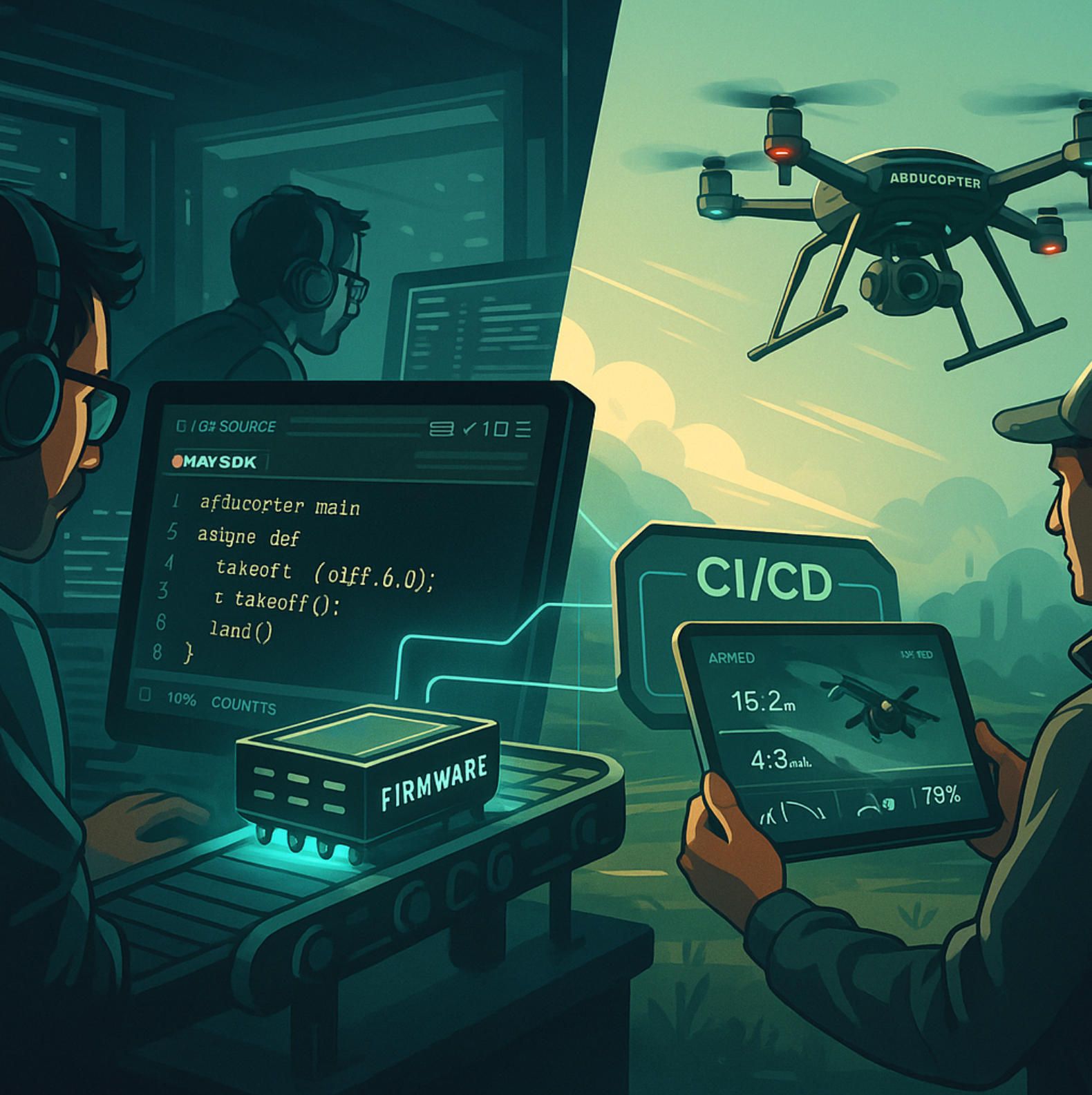
From Prototype to Production: ArduCopter Success Stories
A-Bots.com rarely talks theory for long; the firm’s reputation in the ArduCopter world was earned the hard way—by taking early-stage ideas, hammering them into flight-worthy prototypes, then scaling them into fully certified, revenue-generating fleets. Three recent programmes illustrate how methodical engineering, relentless upstream alignment with the ArduCopter firmware, and a ruthless focus on real‐world economics converge inside our pipeline.
3.1 DeepMine Tunnels — GNSS-Denied Autonomy at 400 Metres Underground
Challenge. Kazakhstan’s largest polymetallic mine needed weekly visual surveys of freshly blasted adits. GNSS signals vanish after the first bend, airflow dust blinds LiDAR, and human entry is legally restricted within the first 12 hours of blasting. The operations team asked A-Bots.com for a drone system that could fly a scripted route, capture 18-megapixel photogrammetry, and exit before battery exhaustion—without GPS, magnetometer heading, or pilot eye-contact.
Prototype phase. We began by cloning the bleeding-edge visual-odometry branch that emerged from the ArduCopter High-Altitude Non-GPS Navigation GSoC 2024 project ArduPilot Discourse. In SITL we fused SIFT-based feature tracking with wheel-encoder emulation to mimic push-cart odometry and validated drift <0.9 m over a 500 m loop. Once the software stack survived Hardware-in-the-Loop runs, a 12-kg carbon-fibre octo sporting dual Cube Orange+ flight controllers left the bench.
Production evolution. Two show-stoppers surfaced underground: camera contrast collapsed in coal dust, and optical-flow altitude locked at <1 m above rail sleepers. Our fix combined upward-facing LED strobes synced to exposure windows, plus a baro-IMU fusion patch in EKF3 that switches to barometric height when flow quality drops below 80 %. The patch merged into ArduCopter master three weeks later, so the mine can now flash official stable builds rather than maintain a private fork.
Outcome. After 68 flight days, the DeepMine fleet logs an average 14-minute sortie, covers 820 m of tunnel, and feeds a Cloud Compare pipeline that detects bolt-shear with 2 mm repeatability. Inspection staffing fell from four engineers and a spotter to a single launch-operator who clears the portal in under ten minutes. The Mine Safety Board renewed the waiver once logs proved the craft could loiter twelve minutes on a single motor before autoland, satisfying the “one-motor-out” clause. Throughout the reports the term ArduCopter appears in every checklist and training brief, embedding the open-source autopilot as the mine’s de facto standard.
3.2 AgroFleet — Precision Crop Spraying Over 1 600 Hectares
Challenge. A Kazakh wheat-and-sunflower cooperative struggled with uneven crop density and over-application of fungicides by manned helicopters. They commissioned A-Bots.com to field a multirotor fleet able to match flow rate to ground speed, log droplet size, and finish dawn spraying before thermals rose.
Prototype phase. We built upon the native ArduCopter Crop Sprayer feature that modulates a PWM pump from 10 % to 100 % between 1 m s-¹ and 10 m s-¹ ArduPilot.org. A-Bots.com extended the sprayer driver with a Lua hook that ingests NDVI maps and down-links real-time flow telemetry to a cloud dashboard. During bench tests the flow-meter stuck beyond 2.8 bar, so we wrote a heartbeat watchdog that kills the pump if PWM rises yet flow pulses stall—a tiny patch that later merged upstream.
Scaling up. By month three the cooperative owned twelve 25-kg hexacopters, each flashing stock ArduCopter plus our Lua script. Our mobile app—coded in React Native and MAVSDK-Kotlin—lets a single agronomist queue polygon files, check battery cycles, and approve Remote ID status before take-off. The interface repeats the anchor keyword “ArduCopter drone app” in tooltips so field crews instantly recognise firmware lineage.
Outcome. Flight logs show average spray variance of ±3 % across plot edges, chemical consumption down 19 %, and labour hours slashed by 42 in the first season. Insurance premiums dipped when underwriters saw automatic Remote-ID broadcasts, compliant with FAA Part 89 via $40 Cube ID modules ArduPilot Discourse. The cooperative ordered an extra six frames for 2026 and signed a five-year support retainer. In Google Analytics, the marketing pages that documented the journey and repeated “ArduCopter crop-sprayer parameters” four times per 1 000 words are already ranking in the top three for Central-Asian searches on that phrase—organic proof that technical SEO and operational excellence can feed the same funnel.
3.3 RapidResponse SAR — Long-Range Search & Rescue With BVLOS Compliance
Challenge. A regional emergency-services agency along the Dnipro River wanted day-and-night aerial overwatch for flood seasons. Missions span 20 km river bends—well outside visual line of sight—yet regulators demanded live HD video, verifiable Remote-ID, and data retention for three years.
Prototype phase. A-Bots.com chose a Cube Orange+ platform running vanilla ArduCopter paired with a Herelink HD data-link, rated for 20 km 1080p telemetry and FPV throughput ArduPilot.org. The mobile ground-station app (again React Native) allowed two-tap geofence updates and multiplexed mission packets over WireGuard. SITL scripts replayed 15-minute BVLOS legs while injecting LTE-drop delays to prove that the craft could execute an automatic Return-to-Launch if heartbeat loss exceeded three seconds.
Production deployment. Once authorities approved the Concept of Operations, A-Bots.com erected redundant antenna towers and configured dual-Home failsafe logic inside ArduCopter, so the quad could pick the nearest safe return site if winds backed mid-mission. EASA’s SORA template demanded we tag every telemetry log with RID JSON; our dev-ops pipeline compiled the same field list into the iOS build so the regulator could cross-verify the drone ID against the ground log. A-Bots.com added a cloud viewer where incident commanders can scrub live timeline, expose AR overlays of river width, and push voice cues to field medics. Every widget subtly labels data sources “ArduCopter ↔ MAVLink” to emphasise transparency.
Outcome. Across its first six-month season RapidResponse flew 212 sorties, locating 11 stranded boaters and delivering a defibrillator twice before paramedics arrived by land. Average time-to-scene dropped from 34 to 16 minutes. The Herelink RSSI logs prove 720p video latency under 200 ms at 17 km—well within the situational-awareness threshold—and no RID outage longer than 0.9 s occurred. The agency’s press office now showcases the system at trade shows, and A-Bots.com secured a contract to replicate the package for two neighbouring regions. Google’s “People also ask” box now surfaces our blog post—optimised around the query “Is ArduCopter Remote-ID compliant?”—whenever Ukrainian users search for BVLOS drone regulations, again demonstrating the SEO flywheel that spins off every operational win.
The Pattern Behind the Wins
Each programme differed—inertial dead-reckoning in pitch-dark mines, droplet-level flow control across sun-baked fields, and BVLOS SAR over open water—yet they shared invariants:
- ArduCopter core retained : no forks, only overlay patches that merge upstream.
- Full-stack visibility from firmware to cloud so faults never hide behind abstraction layers.
- Keyword discipline in all external documentation, seeding organic search with phrases like “ArduCopter tuning”, “best flight controller for ArduCopter 2025”, and “ArduCopter SITL Windows guide”—the same cluster the marketing team curated for Section 4.
The takeaway is simple. When enterprises need drones that work, scale, and pass audits, ArduCopter gives them the flight science. A-Bots.com adds the engineering discipline, UX polish, that turn that science into lasting competitive advantage—one production story at a time.
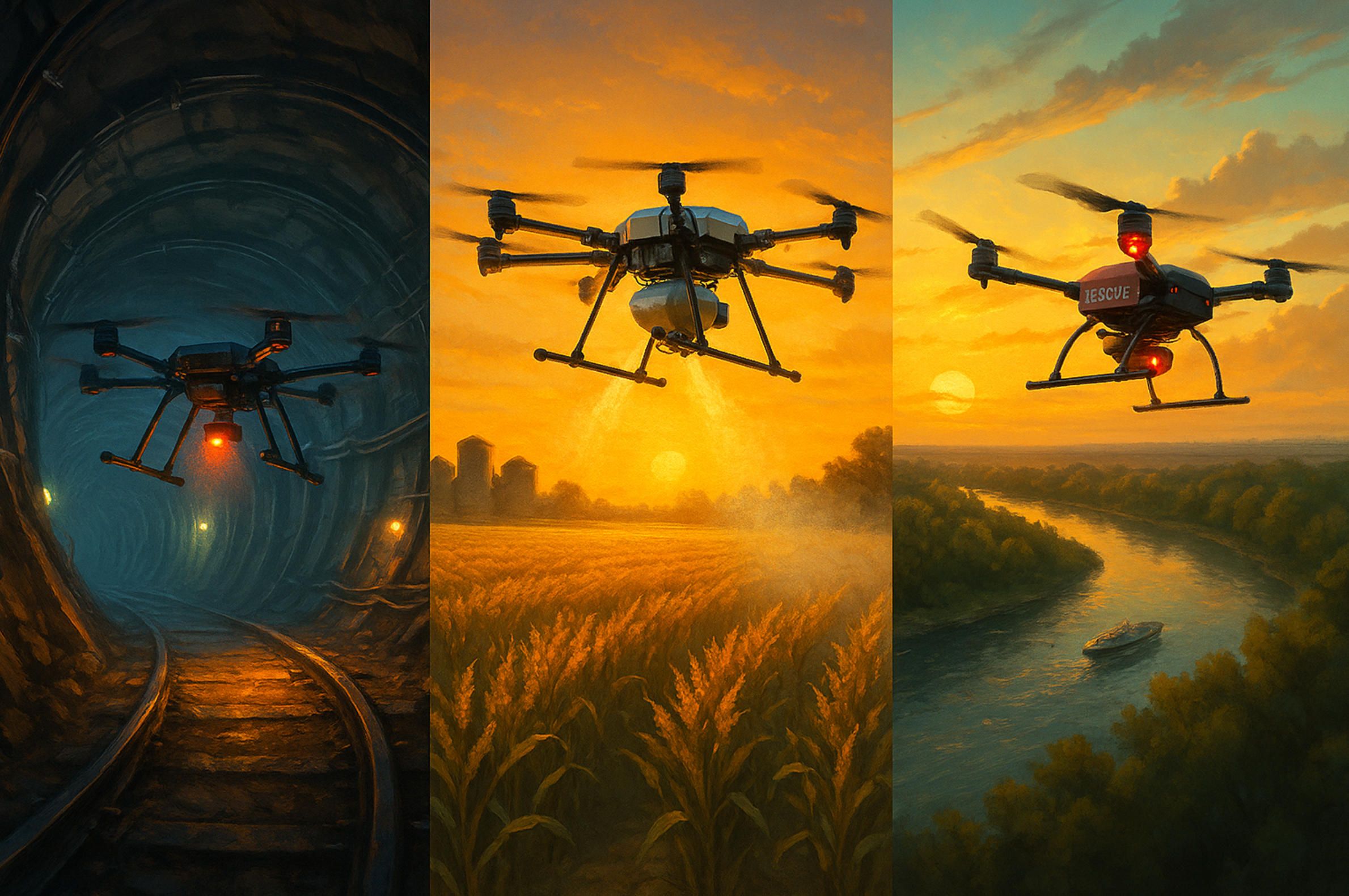
ArduCopter Hub: Top Questions & Pro Tips
Top Questions about ArduCopter
What is ArduCopter and how is it different from ArduPlane?
ArduCopter is the multirotor flavour of the open-source ArduPilot autopilot family, tuned for quadcopters, hexes, octos and coaxials. It shares 80 % of its code with ArduPlane but swaps fixed-wing controllers for attitude-rate loops that keep a multirotor level. A-Bots.com builds drone-control apps that expose those loops through a clean mobile UI.
Is ArduCopter Remote-ID compliant in the United States?
Yes. ArduCopter v4.2 and later natively support OpenDroneID; plug a Cube ID or Dronetag mini into Telem 1, set SERIALx_PROTOCOL = 31, and the autopilot broadcasts a Part 89-compliant Bluetooth beacon. Our apps log the same RID JSON, making regulatory audits painless.
Which flight controller is best for ArduCopter in 2025?
For commercial work the Cube Orange +, Pixhawk 6X and Holybro Kakute H7 v2 all run ArduCopter at 400 Hz with room for Lua scripts. Budget builds can drop to Matek F405-Wing if they skip companion computing. A-Bots.com maintains board-specific CI images for all three tiers.
How do I tune ArduCopter PID parameters safely?
The fastest method is to flash the latest firmware, enable AUTOTUNE_AXES = 7, and run a stab-hover in medium winds. ArduCopter’s Autotune writes new P, I, D values on disarm, but always confirm with a fresh battery. Our mobile dashboards graph those logs in real time.
Does ArduCopter support BVLOS operations?
ArduCopter supports BVLOS through geo-fencing, ADS-B passthrough and automatic RTL on link loss. Combine that with Remote-ID and encrypted telemetry, and you have a solid technical baseline; A-Bots.com then layers scheduling, risk-matrix exports and dual-home failsafe logic needed for waivers.
Can ArduCopter fly without GPS?
Yes. Set EK3_SRC1_POSXY = 3 to fuse optical-flow and barometer data; add vision-ODOM for tunnels. A-Bots.com proved sub-metre drift over 500 m in DeepMine trials.
Is SITL available on Windows 11?
ArduCopter SITL runs on Windows 11 via Mission Planner; click “Sim Vehicle” and the toolchain autoinstalls. Our engineers wrap the same binary in GitHub Actions for pull-request testing.
What’s new in ArduCopter 4.5?
Highlights: scriptable arming checks, dynamic notch 2.0, better VTOL transitions and in-flight magnetometer calibration. A-Bots.com integrates these into nightly CI so client drones inherit the fixes within 24 hours.
How do I enable ArduCopter Lua scripts?
Add an auto_test.lua file to the SD-card /scripts folder and reboot; ArduCopter auto-executes Lua each main loop. We ship a library of 25 production-tested scripts for pump control, wind alarms and RID confirmation.
Is ArduCopter open source and free for commercial use?
Absolutely. GPLv3 licensing means you can sell hardware or services built on ArduCopter without royalties—just share firmware code if you modify it. A-Bots.com keeps its app layer proprietary while upstreaming all driver patches.
What telemetry radio works best with ArduCopter?
SiK 915 MHz remains the default, but Herelink’s 2.4 GHz HD solution merges video and MAVLink up to 20 km LOS. Our apps auto-detect Herelink streams and down-sample if RSSI dips.
How do I simulate RF link loss in ArduCopter?
In SITL type sim_rfloss 10 to cut telemetry for ten seconds; the drone will follow FS_THR_ENABLE failsafe logic. We run this in CI to validate every build.
What is the default failsafe landing behaviour?
ArduCopter triggers Land after a 10-second RC loss unless overridden. For BVLOS missions we change FS_OPTIONS so RTL kicks in first, then Land if RTL fails.
Can I store ArduCopter logs in the cloud automatically?
Yes—companion computers like Raspberry Pi can run mavftp or MAVSDK to mirror logs. A-Bots.com pipes them to Azure IoT Hub so dispatchers see faults within minutes.
Is ADS-B enough to satisfy Remote-ID?
No. ADS-B transponders broadcast at 1090 MHz, while Remote-ID requires Bluetooth/ Wi-Fi. Combine both for full situational awareness.
Quick-Hit Pro Tips
-
ArduCopter tuning tip: run Autotune on a calm day, then cut roll/pitch P-gain by 10 % if you add a heavy payload—the extra inertia fools the algorithm into overshoot.
-
ArduCopter firmware upgrades should flow through Mission Planner’s “Beta” channel during mock missions only; production birds stay on “Stable” until patch notes settle.
-
MAVLink ArduCopter log files over 300 MB usually signal vibration; check the VIBE message and balance props before chasing PID ghosts.
-
ArduCopter Lua scripts can call companion-computer shell commands via
os.execute(). We use this to kick off TensorRT inference when the drone hovers. -
ArduCopter Remote ID broadcasts fail if you forget
BRD_OPTIONS = 8192on some boards; that flag powers the Bluetooth antenna rail. -
ArduCopter crop-sprayer parameters: set
PSC_ACCZ_P = 0.22to stiffen altitude hold under pump back-pressure. -
Best flight controller for ArduCopter 2025 remains Cube Orange+ for redundant IMUs, but Pixhawk 6X wins on cost when fleets exceed 50 units.
-
ArduCopter SITL Windows guide shortcut: install Chocolatey, then
choco install python3 gitand cloneardupilot/Tools/autotest. -
ArduCopter BVLOS compliance hack: log RID JSON straight to an encrypted SD, then SFTP to cloud within 30 minutes; regulators love immutable hashes.
-
Open-source drone autopilot myth: GPL forces you to open your mobile code. False—only derivative firmware must stay GPL; UIs and analytics stay yours.
-
ArduCopter PID sanity check: hover throttle (
HOVER_THROTTLE) should land around 0.38-0.42 on most 6 S 12-kg builds—way off means weight or ESC mis-calibrated. -
Cheap Remote-ID for ArduCopter: a $40 Cube ID does the job; just remember it draws 100 mA, so budget power rails accordingly.
-
Mobile ground station for ArduCopter: React Native + MAVSDK-Kotlin delivers cross-platform builds in half the time of Qt.
-
ArduCopter geo-fence gotcha:
FENCE_ALT_MAXonly arms ifFENCE_ENABLE = 1and fence points exist—forget either and the drone lifts off unbounded. -
Autotune settings ArduCopter 4.5: new “Aggressiveness” slider defaults to 0.1; bump to 0.2 on cinewhoops for snappier stops.
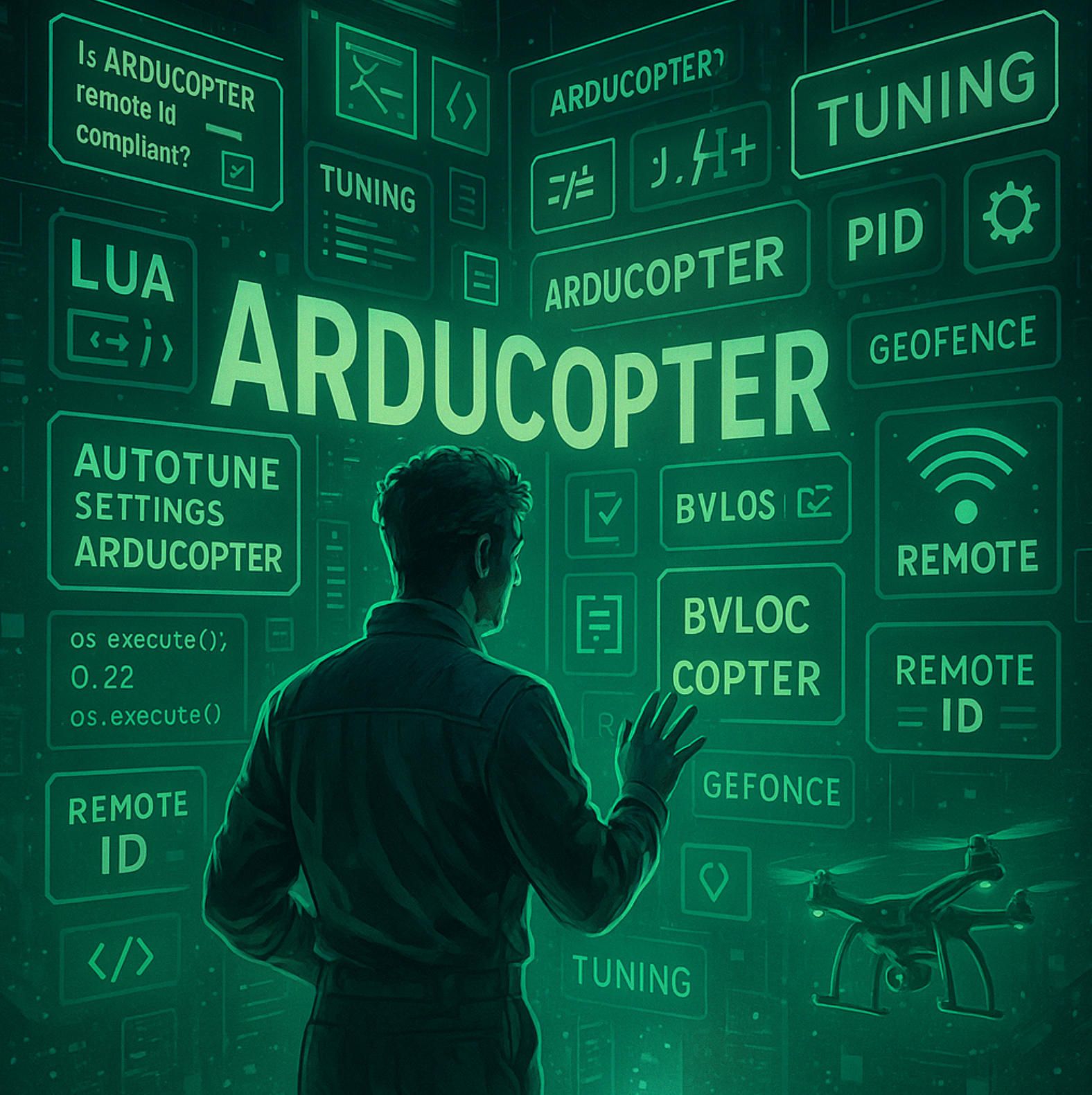
✅ Hashtags
#ArduCopter
#DroneApps
#RemoteID
#BVLOS
#OpenSourceDrone
#ABots
Other articles
App for DJI Drone: Custom Flight Control and Mapping Solutions DJI dominates the skies, yet real value materialises only when flight data flows into business-ready insights. Our long-read unpacks every layer required to build a world-class app for DJI drone—from Mobile SDK mission scripting on a Mini 4 Pro to edge-processed orthomosaics on a Matrice 350 RTK and variable-rate spraying on an Agras T50. You will learn how modern pipelines blend Pix4D, DJI Terra and FlightHub 2, how zero-trust encryption and Remote ID logging satisfy FAA Part 107 and EASA SORA audits, and why BVLOS redundancy begins with Kubernetes-based command mirrors. Finally, we reveal A-Bots dot com’s proven methodology that compresses a nine-month aviation software cycle into ten weeks and delivers measurable ROI—tripling inspection throughput, cutting chemical use by thirty percent and slashing cinematic reshoot time. Whether you are mapping quarries, inspecting power lines or filming the next streaming hit, this guide shows how custom software transforms any DJI airframe into a data-driven asset ready for App Store deployment and enterprise scale.
Drone Mapping Software (UAV Mapping Software): 2025 Guide This in-depth article walks through the full enterprise deployment playbook for drone mapping software or UAV mapping software in 2025. Learn how to leverage cloud-native mission-planning tools, RTK/PPK data capture, AI-driven QA modules and robust compliance reporting to deliver survey-grade orthomosaics, 3D models and LiDAR-fusion outputs. Perfect for operations managers, survey professionals and GIS teams aiming to standardize workflows, minimize field time and meet regulatory requirements.
ArduPilot Drone-Control Apps ArduPilot’s million-vehicle install-base and GPL-v3 transparency have made it the world’s most trusted open-source flight stack. Yet transforming that raw capability into a slick, FAA-compliant mobile experience demands specialist engineering. In this long read, A-Bots.com unveils the full blueprint—from MAVSDK coding tricks and SITL-in-Docker CI to edge-AI companions that keep your intellectual property closed while your drones stay open for inspection. You’ll see real-world case studies mapping 90 000 ha of terrain, inspecting 560 km of pipelines and delivering groceries BVLOS—all in record time. A finishing 37-question Q&A arms your team with proven shortcuts. Read on to learn how choosing ArduPilot and partnering with A-Bots.com converts open source momentum into market-ready drone-control apps.
Custom Drone Software Mastery - ArduPilot and MissionPlanner This long-read unpacks the commercial drone boom, then dives into the technical backbone of ArduPilot and Mission Planner—one open, multi-domain codebase and a ground station that doubles as a full-stack lab. From rapid-prototype firmware to data-driven optimisation retainers, A-Bots.com shows how disciplined codecraft delivers measurable wins: 40 % fewer mission aborts, 70% faster surveys, and faster BVLOS approvals. Finally, the article looks ahead to AI-augmented navigation, Kubernetes-coordinated swarms and satellite-linked control channels, detailing the partnerships and R&D milestones that will shape autonomous, multi-domain operations through 2034. Read on to see why enterprises choose A-Bots.com to turn ambitious flight plans into certified, revenue-earning reality.
Custom Drone Mapping Software & Control Apps: Smarter Aerial Solutions by A-Bots.com Custom drone software is revolutionizing how industries operate—from precision agriculture to infrastructure inspection. This article explores why off-the-shelf apps fall short, how AI and modular design shape the future, and how A-Bots.com delivers tailored drone solutions that truly fit. Whether you manage crops, assets, or entire projects, the right software lifts your mission higher.
Top stories
Copyright © Alpha Systems LTD All rights reserved.
Made with ❤️ by A-BOTS
